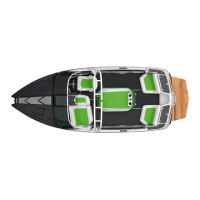2017 OWNERS MANUAL / 462
DRAFT – The depth of the boat below the water line, measured verti-
cally to the lowest part of the hull.
FENDER – A cushioning device used on the side of a vessel or dock
to absorb impact or friction.
FORE – Toward the front or bow of the boat. Opposite of aft.
FREEBOARD – The distance from the waterline to the upper surface
of the side of the deck.
FUEL SENDING UNIT – The electrical device mounted on the fuel
tank which communicates fuel levels to the dashboard fuel gauge.
FUEL MANAGEMENT SYSTEM – An internal computer system in
MasterCraft boats that calculates fuel burn and fuel tank volume to
give operators precise fuel tank fill levels.
GIVE-WAY BOAT – (1) Term for the boat that must take whatever
action necessary to keep well clear of the boat with the right-of-way
in meeting or crossing situations. (2) The burdened boat.
GUNWALE (GUNNEL) – The rail or upper edge of a boat’s hull side.
HEAD – (1) A marine toilet. (2) Used to describe the compartment or
location of a marine toilet.
HELM - The steering wheel or command area.
HULL – The structural body of a boat below deck.
HYPOTHERMIA – A physical condition in which the body loses heat
faster than it can produce it.
KEEL – The lowest portion of the boat; extending fore and aft along
the boat’s hull bottom.
LINE – Rope. In a marine environment rope is referred to as a “line.”
LIST – Leaning or tilt of a boat toward the side.
MAKING WAY – Making progress through the water.
MARINE CHART – Seagoing maps showing depths, buoys, naviga-
tion aids.
MID SHIP – In the vicinity of the mid-length of a boat, technically the
exact half way between the bow and the stern.
MOORING – An anchor, chain, or similar device that holds a boat in
one location.
NAVIGATION AID – Recognizable objects on land or sea such as
buoys, towers or lights, used to identify safe and unsafe waters.
NAVIGATION LIGHTS - See RUNNING LIGHTS.
NMMA – National Marine Manufacturer’s Association.
NO-WAKE SPEED – The speed at which a boat travels to produce no
visible wake.
OUTBOARD - (1) Toward or beyond the hull sides of the boat. (2) A
detachable engine mounted to the transom of the boat.
PFD – Personal flotation device.
PLANING HULL – A hull designed to lift, thereby reducing friction and
increasing eciency.
PORPOISE – A condition in which the bow bounces up and down
caused by trimming the engine too far out of the water. This is par-
ticularly apparent in boats running at high speeds with full ballast
tanks.
PORT – (1) The left side of a boat when facing the bow. (2) A destina-
tion or harbor.
PRIVILEGED BOAT – Term used for the boat with the right-of-way.
PROPELLER - A mechanical device for propelling a boat, consisting
of a revolving shaft with two or more broad, angled blades.
RIGHT-OF-WAY – Term for the boat that has priority in meeting or
crossing situations. The stand on or privileged boat.
RUB RAIL – The rubber extrusion that is fastened over the hull and
deck joint. The rub rail wraps all the way around the deck and hull.
RUDDER – A vertical plate or board used for steering the boat.
RUNNING LIGHTS - Also called navigation lights. Lights required for
operating a boat between sun-down and sun-up. These include two
navigational lights: red (port) and green (starboard), and one white
all-around or mast light.
SLIP – The linear distance between the pitch (or advance) of the
propeller and the actual distance it moves through the water.
STAND ON BOAT – Term for the boat that must maintain course and
speed in meeting or crossing situations. The privileged boat.
STARBOARD – The right side of a boat when looking toward the bow.
STERN – The aft or rear end of a boat.
STOW – To store cargo o of the deck usually in designated storage
compartments.
STRINGER – Fiberglass reinforcements under the floor that stien
the hull bottom.
SURGE BRAKES – A type of trailer braking system designed to auto-
matically actuate when the tow vehicle’s brakes are applied.
TRANSDUCER – The unit that sends/receives signals from the
depth sounder.
TRANSOM – The transom is the transverse, vertical section that
makes up the rear, or stern of a boat directly opposite the bow.
UNDERWAY – A boat in motion; i.e., not moored or anchored.
USCG – United States Coast Guard.
VISUAL DISTRESS SIGNAL – A device used to signal the need for
assistance such as flags, lights or flares.
WAKE – The waves that a boat leaves behind when moving through
the water.
WAKE SHAPING DEVICE - Devices that alter the flow of water to
change a wake’s size and shape.
WATERLINE – The line of the water’s edge when the boat is afloat.
WATERWAY – A navigable body of water.
WETTED SURFACE – The area of the hull under the water line and
any underwater or running gear mounted to the hull or transom.

